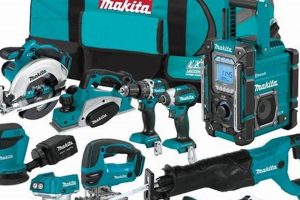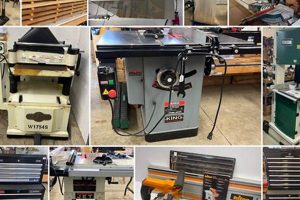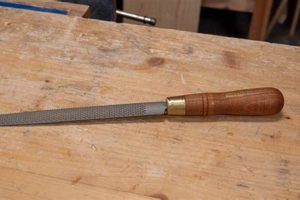The phrase identifies implements and equipment employed in the crafting and shaping of wood, specifically within a defined geographical region. This encompasses a range of hand tools, power tools, machinery, and accessories utilized by craftspeople, hobbyists, and industrial manufacturers across the state. Examples include hand planes, saws, lathes, sanders, and various measuring and marking devices.
Access to quality instruments significantly impacts the efficiency, precision, and safety of woodworking projects. Local availability fosters community building among woodworkers, supports regional economies, and ensures convenient access to necessary supplies and services. Historically, the region has been a hub for manufacturing and craftsmanship, leading to a concentration of suppliers and resources related to the craft.
The following sections will delve into the types of implements readily available, prominent retailers and suppliers in the area, avenues for acquiring used or vintage equipment, and resources available for learning and improving woodworking skills.
Essential Considerations When Procuring Woodworking Equipment
This section outlines crucial aspects to consider when acquiring instruments for shaping wood within the specified locale. Adhering to these guidelines can ensure optimal performance, safety, and value.
Tip 1: Prioritize Safety Equipment: Before acquiring any power tools, invest in appropriate personal protective equipment (PPE). This includes safety glasses, hearing protection, and dust masks to mitigate risks associated with woodworking.
Tip 2: Assess Project Requirements: Determine the specific types of projects to be undertaken. This will inform the selection of essential tools, preventing unnecessary expenditure on equipment that is not immediately required.
Tip 3: Research Reputable Brands and Suppliers: Investigate the reputation of various manufacturers and local suppliers. Read reviews and solicit recommendations from experienced woodworkers to ensure product quality and reliable customer service.
Tip 4: Consider Used or Refurbished Options: Explore the availability of pre-owned instruments. Well-maintained vintage or refurbished equipment can offer significant cost savings without compromising functionality.
Tip 5: Inspect Equipment Thoroughly: Before finalizing any purchase, carefully inspect the equipment for any signs of damage, wear, or malfunction. Test power tools to ensure they operate smoothly and safely.
Tip 6: Familiarize Yourself with Operating Instructions: Prior to utilizing any instrument, thoroughly review the manufacturer’s instructions and safety guidelines. Proper operation minimizes the risk of accidents and ensures optimal performance.
Tip 7: Invest in Quality Measurement Tools: Accurate measurements are crucial for achieving precise and professional results. Invest in reliable measuring tapes, squares, and calipers.
Acquiring the appropriate instruments and following safety protocols are vital for successful woodworking endeavors. Thoughtful planning and careful selection will enhance the crafting experience and ensure quality outcomes.
The subsequent section will address resources for finding training and educational opportunities within the region.
1. Availability
Availability, regarding implements for shaping wood in Ohio, dictates the accessibility of these crucial resources to woodworkers throughout the state. This accessibility exerts a direct influence on the scope and nature of woodworking projects that can be undertaken. When access is limited, projects may be constrained by the available inventory, affecting both material and tool choices. For instance, the presence of well-stocked local retailers, both physical and online, directly increases the feasibility of large-scale or specialized projects. Conversely, the absence of such retailers might compel individuals to rely on less convenient or more expensive alternatives, potentially delaying or modifying projects.
The economic impact of instrument availability also warrants consideration. Areas with readily accessible suppliers tend to foster a more vibrant woodworking community, attracting both hobbyists and professional craftspeople. This stimulates local economies through increased commerce and job creation within related industries. Moreover, the accessibility factor dictates the type of woodworking prevalent in a specific area. Urban centers might see a focus on smaller-scale projects due to space constraints and easier access to a variety of specialized equipment, while rural regions might favor larger-scale woodworking due to larger workshops and a greater emphasis on more general-purpose instruments.
In summary, accessibility is a critical component of woodworking within the specified geographic location. It influences project feasibility, shapes local economies, and impacts the types of woodworking activities pursued. Challenges related to accessibility, such as limited inventories or high transportation costs, can significantly hinder woodworking endeavors. Addressing these challenges is essential for fostering a thriving and diverse woodworking community throughout Ohio.
2. Quality
The inherent quality of implements utilized within Ohio’s woodworking sector profoundly influences project outcomes and worker safety. Superior materials and precise manufacturing yield instruments that maintain accuracy, reduce the likelihood of malfunctions, and extend operational lifespan. Consequently, investment in high-caliber equipment translates directly into enhanced efficiency, fewer instances of rework, and a safer working environment. For instance, a precision-engineered jointer ensures flat, square edges for joining boards seamlessly, while a poorly manufactured model may produce uneven results, requiring additional corrective measures and increasing material waste.
The correlation between quality and longevity is particularly relevant to woodworking. Durable instruments, constructed from robust materials, withstand the rigors of frequent use and resist wear and tear, minimizing the need for replacements and associated costs. This is exemplified by vintage hand tools, often prized for their superior craftsmanship and lasting performance compared to some contemporary alternatives. Furthermore, the inherent design of high-quality equipment often incorporates ergonomic considerations, minimizing user fatigue and reducing the risk of repetitive strain injuries. Professional woodworkers and serious hobbyists recognize this value proposition and prioritize investing in reliable, well-made tools.
Ultimately, the quality of equipment is a determining factor in the success and sustainability of woodworking endeavors within Ohio. While lower-priced alternatives may present initial cost savings, the long-term benefits of opting for high-quality instruments, including increased accuracy, enhanced safety, extended lifespan, and reduced operational costs, far outweigh the initial investment. Recognizing this principle is paramount for both individual woodworkers and businesses seeking to maintain a competitive edge and uphold standards of excellence.
3. Cost
The financial aspect is a primary determinant in the acquisition and utilization of implements for shaping wood within the state. The cost spectrum ranges from entry-level hand tools to sophisticated computer-controlled machinery, influencing accessibility and the scale of woodworking projects undertaken.
- Initial Investment Threshold
The upfront expense associated with procuring essential instruments sets a barrier to entry for hobbyists and small businesses. A comprehensive set of hand tools can represent a significant outlay, while power tools and machinery often require a more substantial capital investment. This impacts the demographic able to participate in the craft and influences the types of projects pursued.
- Maintenance and Operating Expenses
Beyond the initial purchase, ongoing costs associated with maintenance, repairs, and consumables (e.g., saw blades, sandpaper, finishes) contribute to the total cost of ownership. Power tools and machinery incur electrical costs, while hand tools necessitate sharpening and occasional repairs. These recurring expenses must be factored into project budgeting and business planning.
- Depreciation and Resale Value
The value of equipment depreciates over time due to wear and tear and technological advancements. Understanding the depreciation curve is crucial for businesses managing assets and for individuals considering resale. High-quality brands often retain greater resale value than less durable alternatives, impacting long-term financial considerations.
- Impact on Project Profitability
The cost of instruments directly affects the profitability of woodworking projects, particularly for businesses. Accurate cost accounting, including tool depreciation, maintenance, and consumables, is essential for determining pricing and ensuring financial viability. Investing in efficient, high-quality equipment can reduce labor costs and material waste, thereby improving overall profitability.
These factors highlight the critical role that cost plays in shaping the woodworking landscape within Ohio. The interplay between initial investment, ongoing expenses, and project profitability dictates the feasibility and sustainability of woodworking endeavors, influencing both individual craftspeople and commercial enterprises.
4. Maintenance
The longevity and optimal performance of implements used in shaping wood within Ohio are intrinsically linked to consistent and thorough upkeep. Proper care prevents premature degradation, ensures user safety, and preserves the accuracy required for quality woodworking. This section elucidates key aspects of maintenance pertinent to implements utilized within the region.
- Sharpening and Edge Preservation
Maintaining sharp cutting edges on saws, chisels, and planes is paramount for efficient and safe operation. Dull edges require increased force, leading to potential workpiece damage, user fatigue, and heightened risk of injury. Regularly sharpening tools using appropriate techniques and equipment ensures clean cuts and precise shaping. The frequency of sharpening depends on tool usage and material hardness, but routine inspection and timely sharpening are critical.
- Cleaning and Lubrication
Removing accumulated sawdust, resin, and debris from instruments is essential for preventing corrosion and ensuring smooth operation. Lubricating moving parts, such as gears, bearings, and threaded components, reduces friction and wear. Regular cleaning and lubrication extend the lifespan of tools, minimize malfunctions, and maintain optimal performance. Specific lubricants appropriate for woodworking equipment should be used, avoiding products that attract dust or damage finishes.
- Inspection and Calibration
Periodic inspection of instruments for signs of damage, wear, or misalignment is crucial for maintaining accuracy and safety. Checking for loose screws, frayed cords, and worn components allows for timely repairs or replacements. Calibrating measuring devices, such as squares and levels, ensures precise measurements and prevents errors in woodworking projects. Maintaining accurate calibration is particularly important for intricate or large-scale projects requiring tight tolerances.
- Storage and Environmental Control
Proper storage protects implements from environmental factors that can cause damage or degradation. Storing tools in a dry, climate-controlled environment prevents rust and corrosion. Organizing tools in designated storage areas prevents damage and facilitates easy access. Protecting blades and cutting edges with covers or sheaths prevents accidental injury and preserves sharpness. Implementing effective storage practices minimizes maintenance requirements and extends the lifespan of instruments.
These facets underscore the importance of diligent maintenance practices for woodworking tools utilized within Ohio. By prioritizing sharpening, cleaning, inspection, and proper storage, woodworkers can ensure the longevity, accuracy, and safety of their implements, ultimately enhancing the quality and efficiency of their craft.
5. Safety
The effective and safe operation of instruments for shaping wood within Ohio is inextricably linked to a comprehensive understanding and implementation of safety protocols. Improper handling or inadequate safety measures while utilizing these implements can lead to severe injuries, ranging from minor cuts and abrasions to limb amputations and fatalities. The inherent dangers associated with woodworking equipment, such as high-speed rotating blades and the potential for projectiles, necessitate a proactive and diligent approach to safety. Cause and effect are demonstrably clear: neglecting safety guidelines increases the probability of accidents, while adhering to them significantly reduces the risk of harm. The availability of safety equipment, such as eye protection, hearing protection, dust masks, and appropriate work attire, is crucial but insufficient without proper training and adherence to established safety procedures.
Safety is not merely an adjunct to the phrase but a critical component. For example, the proper use of push sticks and feather boards when operating a table saw minimizes the risk of kickback, a common and potentially devastating woodworking accident. Similarly, ensuring adequate ventilation when applying finishes and sealants reduces exposure to hazardous fumes, mitigating potential health risks. Regular inspection of tools for defects, such as frayed cords or loose blades, is essential for preventing malfunctions that could lead to accidents. Furthermore, the implementation of lockout/tagout procedures during maintenance or repairs safeguards against accidental activation of equipment, preventing serious injury. Real-life examples of woodworking accidents underscore the practical significance of safety knowledge and practices. Reports from the Occupational Safety and Health Administration (OSHA) frequently cite violations related to inadequate machine guarding, improper use of personal protective equipment, and insufficient training as contributing factors to woodworking-related injuries.
In summary, safety is an inseparable and paramount consideration when using implements for shaping wood within Ohio. The challenges associated with promoting a safety-conscious culture within woodworking environments involve ongoing training, consistent reinforcement of safety protocols, and a commitment to providing and maintaining appropriate safety equipment. By prioritizing safety, woodworkers can mitigate risks, prevent accidents, and foster a more productive and sustainable working environment. The connection between safety and the proper employment of shaping wood instruments is crucial and non-negotiable.
6. Innovation
Innovation is a driving force within the woodworking sector, continually shaping the design, functionality, and application of instruments for shaping wood across Ohio. This evolution impacts efficiency, precision, safety, and the types of projects achievable.
- Material Advancements
The integration of advanced materials, such as high-strength alloys and composites, enhances the durability and performance of instruments. For instance, the use of carbide-tipped saw blades extends cutting life and improves precision when working with hardwoods. Composite materials are also used in tool bodies to reduce weight and improve ergonomics, lessening user fatigue. Ohio-based manufacturers may be early adopters of these new materials to produce higher quality, longer lasting instruments.
- Digital Integration and Automation
Computer Numerical Control (CNC) technology has revolutionized woodworking, enabling precise and repeatable cutting, shaping, and joinery. CNC routers and lathes automate complex tasks, increasing productivity and reducing the potential for human error. Smaller workshops in Ohio are increasingly integrating these technologies to compete with larger manufacturers. Additionally, digital measuring tools and CAD/CAM software enhance design capabilities and streamline workflows.
- Ergonomic Design and Safety Features
Innovation extends to the ergonomic design of instruments, prioritizing user comfort and safety. Features such as vibration dampening, adjustable handles, and integrated dust collection systems reduce strain and exposure to harmful particles. Advanced safety mechanisms, such as automatic blade brakes and sensor-based shut-off systems, minimize the risk of accidents. Local woodworking tool manufacturers are likely incorporating these advancements to remain competitive and compliant with safety regulations.
- Power Source and Efficiency Enhancements
The development of cordless power tools utilizing advanced battery technology has significantly improved portability and convenience. Brushless motors offer increased power and efficiency, extending battery life and reducing maintenance requirements. These innovations allow woodworkers to operate in remote locations and enhance overall productivity. Local tool vendors may stock a wide range of cordless options to cater to the evolving needs of their clientele.
These various facets of innovation collectively influence the woodworking landscape in Ohio. By embracing these advancements, woodworkers can improve efficiency, enhance safety, and expand the scope of their craft. The ongoing integration of new technologies and materials ensures that the sector remains dynamic and competitive.
Frequently Asked Questions
This section addresses common inquiries pertaining to instruments employed for shaping wood, specifically within the Ohio context. The aim is to provide clarity and guidance on essential considerations.
Question 1: What are the fundamental instrument requirements for commencing woodworking activities in Ohio?
The bare essentials include a hand saw (crosscut and rip), a set of chisels, a hand plane, a measuring tape, a square, a marking gauge, and appropriate safety eyewear. This foundational collection enables basic shaping and joinery tasks.
Question 2: Where can reliable sources for acquiring shaping wood instruments be located within Ohio?
Reputable suppliers encompass dedicated woodworking stores, established hardware retailers with specialized departments, and online vendors with a proven track record. Recommendations from experienced woodworkers are invaluable.
Question 3: How can the authenticity and condition of used or vintage equipment be ascertained?
Thorough physical inspection is crucial, looking for signs of damage, wear, or improper repairs. Testing the tool’s functionality, if possible, is recommended. Consulting with experienced woodworkers or antique tool specialists can provide expert assessments.
Question 4: What are the legal stipulations regarding the safe operation of power instruments for shaping wood within Ohio?
While specific state regulations may vary, adherence to Occupational Safety and Health Administration (OSHA) guidelines is paramount. Employers are responsible for providing a safe working environment, including proper training and the use of personal protective equipment.
Question 5: What are the recommended maintenance procedures for prolonging the operational life of shaping wood instruments?
Regular sharpening of cutting edges, cleaning and lubrication of moving parts, periodic inspection for damage, and proper storage in a dry environment are essential for maintaining optimal performance and preventing premature deterioration.
Question 6: What is the typical cost associated with establishing a modestly equipped woodworking shop in Ohio?
The financial outlay varies significantly based on instrument choices and shop size. A basic setup with essential hand tools and a few power tools can range from $500 to $2000. A more comprehensive shop with advanced machinery can easily exceed $10,000.
In summary, acquiring appropriate instruments, understanding safety protocols, and implementing proper maintenance procedures are crucial for successful woodworking endeavors within Ohio. Thoughtful planning and informed decision-making will enhance the crafting experience and ensure quality outcomes.
The subsequent section will address resources for finding training and educational opportunities within the region.
Conclusion
This exploration of “woodworking tools ohio” has underscored the critical role that equipment plays in the region’s woodworking landscape. Access to quality instruments, whether hand tools or sophisticated machinery, directly influences project outcomes, worker safety, and the economic viability of woodworking enterprises. Furthermore, the continuous evolution of instrument technology and materials necessitates ongoing learning and adaptation to maintain competitiveness and achieve optimal results.
The future of woodworking in Ohio hinges on embracing innovation, prioritizing safety, and ensuring accessibility to appropriate equipment for both professionals and hobbyists. A commitment to these principles will foster a thriving woodworking community and sustain the legacy of craftsmanship within the state.







